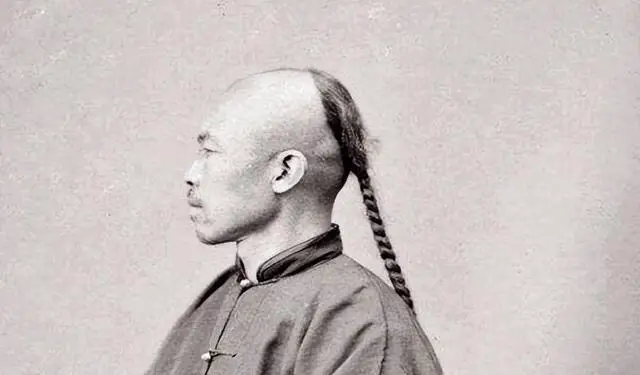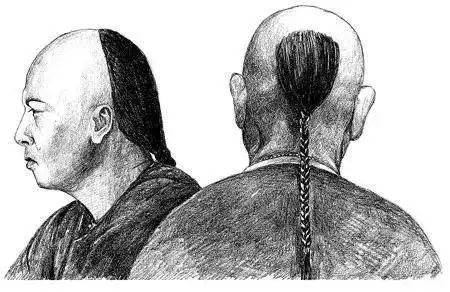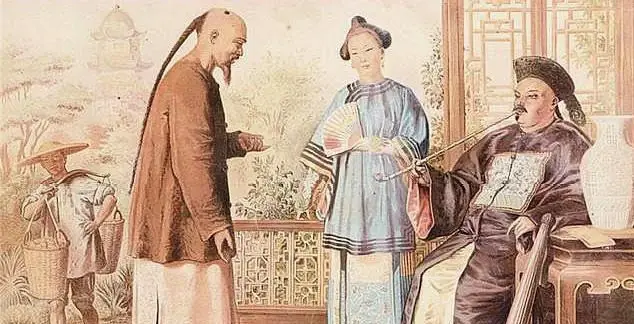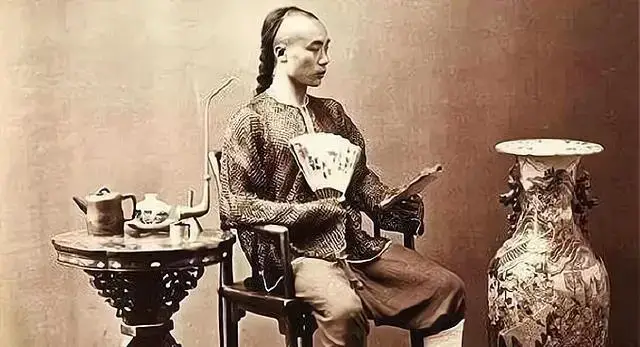Hairstyles have been used as a form of self-expression and cultural identity for centuries. One such hairstyle that holds significant cultural and historical importance is the queue hairstyle. This hairstyle was prominent in Chinese culture during the Qing dynasty, and it holds a unique place in history.
What is the queue hairstyle?

Popular in China during the Qing dynasty, the queue hairstyle was also known as the Manchu hairstyle or Cue. Each and every man in China at the time was expected to sport this hairstyle and those who didn’t were threatened with death.
The hair is shaved short on top and to the sides, with a long ponytail left at the back. Ponytails came in many different lengths and styles that showed how old someone was, what they did for a living, and where they stood in society.
The Manchus, who overran China in the middle of the 17th century, are responsible for popularizing the queue hairstyle. The queue hairstyle was imposed on the Chinese by the Manchu, who braided their hair to set themselves apart from the Han Chinese. The distinctive hairdo was a powerful symbol of Manchu superiority and cultural continuity.
The hairstyle became a political symbol in China during the Qing dynasty. It stood for both national pride and loyalty to the government.The queue hairstyle was a sign that Chinese men were willing to be ruled by the Manchus.The Qing government used the hairstyle as another surveillance tool to track the populace and spot potential rebels.
There was some debate about the queue cut. The hairstyle was seen as a symbol of Chinese subjugation by their Manchu rulers and, as such, was widely disliked by the Chinese people. Many people during the Qing dynasty rebelled against the hairstyle by shaving their heads instead of adopting the queue.
There were some moral and ethical questions raised by the hairstyle, but it managed to stay in style for over two centuries. During the Qing dynasty, the queue hairstyle became an important part of Chinese identity, serving as a symbol of Chinese culture and tradition.
Chinese culture has long valued the art of braiding. The Han dynasty (206 BC–220 AD) saw the beginning of men in China styling their hair in braids. Officials and educated men of the time period often sported braided hairstyles as a symbol of their status.
The Tang dynasty, which ruled from 618 to 907 A.D., saw a decline in braiding’s popularity. The queue hairstyle, which revived braiding, was popular only during the Qing dynasty.
It wasn’t easy to maintain the queue hairstyle. The constant washing and combing of hair was a major time sink. It was also a pain to wear, as the ponytail’s extra mass could lead to a stiff neck or headache.
The queue haircut persisted for a long time despite these obstacles. The hairstyle was worn by men of all social classes to show support for the Qing dynasty and for traditional Chinese values.
With the fall of the Qing dynasty in 1912, the queue haircut began to go out of style. The new government actively pushed its citizens to abandon the practice, and in 1922 it was officially outlawed.
The Chinese public has moved on from the queue hairstyle. However, it still holds considerable significance in Chinese heritage. The hairstyle is an integral part of Chinese culture and played a crucial role in forging the Qing dynasty’s Chinese identity.
Purpose of the Queue Hairstyle

During China’s Qing dynasty, the queue hairstyle served a number of functions. The Manchu people, who had recently conquered China, wanted to be easily distinguished from the Han Chinese, so they adopted a distinctive hairstyle. Unlike the Han Chinese, whose hair is typically worn long and loose, the Manchu wear theirs in a braid. The Manchu used the queue hairstyle as a symbol of their superiority and continued commitment to their culture.
The Qing government used the hairstyle as a tool for social control and surveillance. All male Chinese citizens were required to adopt the hairstyle, and those who didn’t were threatened with death if they didn’t conform. This hairstyle was mandated by the government as a means of social control and dynastic loyalty.
Among other things, Chinese men could show their support for the Qing dynasty by sporting the queue hairstyle. The hairstyle was seen as a way to show respect for and identification with Chinese culture and customs, as well as a sign of obedience and loyalty.
There was also cultural and social significance to the hairstyle. According to factors such as age, profession, and social standing, the queue had varying lengths and looks. Members of the imperial family, for instance, sported a particular style of queue while commoners opted for a less ornate look. During the Qing dynasty, the hairstyle was a crucial part of Chinese culture and tradition, and it helped define the nation’s identity.
When did Chinese men start braiding?
Chinese culture has long valued the art of braiding. The Han dynasty, which lasted from 206 BC to 220 AD, is often cited as the earliest known instance of hair braiding. Officials, scholars, and other members of the elite class often sported braided hairstyles during this time.
In the Han dynasty, men’s hairstyles often included a topknot, in which the hair was gathered on top of the head and fastened with a hairpin or band. But as the dynasty went on, a new style of topknot came into fashion, and braids became very popular.
Central Asian culture is often seen as the reason why braided hairstyles were so popular during the Han dynasty.Since the Han dynasty traded a lot with Central Asia, ideas and cultural practices moved freely between the two areas.Therefore, Chinese women began wearing the braided hairstyles that were all the rage in Central Asia.
The Tang dynasty, which ruled China from 618 to 907 A.D., saw the continuation of the fashion for braided hairstyles. Exquisite knots and braids were all the rage at this time, and hairstyling itself rose to the level of an art form. Intricate hairstyles, particularly among women, were common and frequently adorned with flowers and other ornaments.
However, during the Song dynasty (AD 960–1279), the practice of braiding fell out of favor. Loose hairstyles became popular for both sexes during this time, and braids went out of style. The influence of Confucianism, which valued simplicity and modesty in outward appearance, contributed to the decline of braiding.
On June 15, 1645, the Qing dynasty issued a decree called the “Shave Order.” The Shave Order referred to the policy of the Qing government in the late Ming and early Qing dynasties, which used “those who do not comply will be executed” as a means to forcibly require all ethnic groups under its rule, mainly the Han, Mongolian, and other southern minority groups, to shave their hair in the style of the Manchu people.
The queue hairstyle, which revived braiding, was popular only during the Qing dynasty. The queue hairstyle entailed shortening or removing hair from the top and sides of the head while leaving a long ponytail in the back, which was frequently braided. According to factors such as age, profession, and social standing, the queue had varying lengths and looks. During the Qing dynasty, the queue was enforced on all adult male Chinese citizens under penalty of death for those who did not comply.
Braids were considered more than just a fashion accessory during the Qing dynasty; they were also a symbol of loyalty and submission to the government. It was the Qing dynasty and respect for Chinese culture and tradition that the queue hairstyle represented for men in China.
In modern China, women, especially, frequently sport braided hairstyles. In celebration of special events like weddings and festivals, braids are frequently accessorized with flowers and other adornments. Braided hairstyles in modern China often take cues from the past but are updated to reflect current fashion.
End of the Queue Hairstyle
The end of the queue hairstyle in China was a result of significant political and social changes in the country. The queue had been mandatory for all Chinese men since the Qing dynasty, but it became a source of controversy and resentment in the early 20th century.
In the late 1800s and early 1900s, China was undergoing significant political upheaval, with many Chinese people pushing for modernization and reform. The queue hairstyle was seen by some as a symbol of the old regime, and there were growing calls for it to be abolished.
The Wuchang Uprising of 1911 set off a domino effect across the country, with fourteen of the country’s eighteen provinces eventually declaring their independence. There was a gradual transition of power from the Qing court to Yuan Shikai.
The Qing court decided to end the ban on cutting the queue on December 7, 1911, with Yuan Shikai’s support, in an effort to win back the people’s favor. A royal edict declared that all citizens of the empire were free to skip the lines at their leisure.
In doing so, the Qing dynasty effectively ended the practice of waiting in line. The Qing dynasty fell in two months.
In 1912, the Qing dynasty was overthrown and the new Republic of China was established. The new government abolished the queue hairstyle, and Chinese men were free to wear their hair in any style they chose.
The abolition of the queue was a significant moment in Chinese history, symbolizing the end of the old regime and the beginning of a new era. It was also a sign of the growing influence of Western culture in China, as many Chinese men began to adopt Western hairstyles.
The end of the queue hairstyle was not without controversy, however. Some Chinese people saw it as a betrayal of Chinese culture and tradition, and there were concerns that it would lead to a loss of national identity.
Despite these concerns, the end of the queue hairstyle paved the way for new hairstyles and fashion trends in China. Today, Chinese people are free to express themselves through their hairstyles, and there is a wide range of styles and trends to choose from.
different types of Chinese queue
Chinese money rat tail braids

In the early Qing Dynasty, the rulers issued a hair-cutting decree that stipulated, “Only leave one coin-sized hair on the top of the head, and those who have hair weighing more than one coin will be executed.” The hairstyle that the early Qing Dynasty Manchu men wore was called “Jin Qian Shu Wei Bian,” which meant that the hair around the head was shaved off, leaving only a small patch of hair in the center of the head, which was as big as a coin. The hair was then braided into a thin braid that needed to pass through the square hole of the Qing Dynasty’s copper coin to be considered qualified. In addition, the facial hair of Qing Dynasty men was only allowed to grow to about ten hairs above the upper lip.
In order to Manchurianize the Han people and consolidate the Manchus’ ruling status, it was necessary to resist Sinicization and use coercive measures to require the Han people to change their customs. At the same time, it was also to preserve the Manchus’ own national traditions. In the early Qing Dynasty, all men were required to shave their heads and wear Jin Qian Shu Wei Bian. The hair-cutting decree issued at the time stated, “Jin Qian Shu Wei Bian is the new dynasty’s elegant policy; wearing a high hat and broad belt is the crude rule of a declining country.” Qin Shizhen’s “The Grassroots of Zhejiang Province” also mentioned, “Every descendant of Yan and Huang was forced to shave their hair that their parents dared not destroy, leaving only a patch of hair as big as a copper coin, which was humiliatingly braided into a small braid called ‘Jin Qian Shu Wei’.” Therefore, in the early Qing Dynasty, almost all men wore Jin Qian Shu Wei Bian.
Chinese yin and yang hairstyles

In the later period of the Qing Dynasty, starting from the reign of Jiaqing, the hairstyle of Chinese men gradually evolved into shaving only some of the hair around the head, leaving the hair in the middle of the head to grow long, and then dividing it into three strands and braiding them into a braid at the back of the head. This is commonly known as the “Yin Yang head” hairstyle.
Conclusion
The queue hairstyle holds significant cultural and historical importance in Chinese culture. It was a symbol of dominance and cultural identity during the Qing dynasty, and it played a significant role in shaping Chinese history. While the queue hairstyle may no longer be in fashion, it remains an important part of Chinese history and culture.